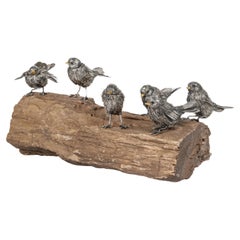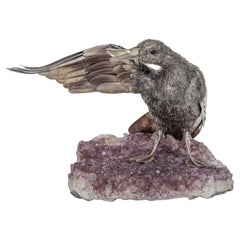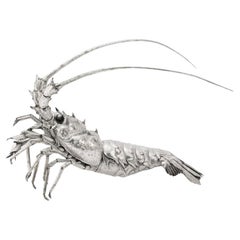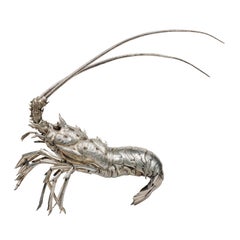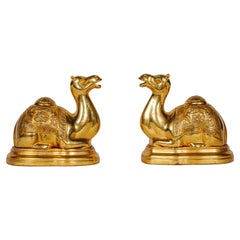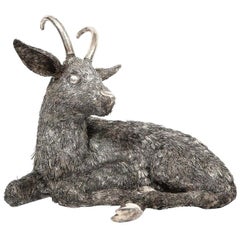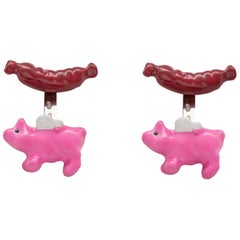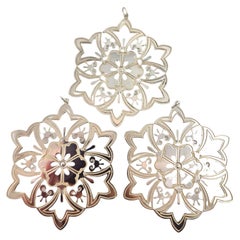Solomon Treasure Figurines and Sculptures
to
3
12
8
3
3
2
7
5
3
3
3
1
15
1
17
7
1
1
1
1
5
2
1
1
1
2
17
17
Adorable Family of Six Buccellati Sterling Silver Furry Chicks on Petrified Wood
By Mario Buccellati
Located in Queens, NY
An Adorable Family of Six Italian Buccellati Sterling Silver Furry Chicks Resting on a Petrified Wood Base, Milan 20th Century
This enchanting creation by the renowned Italian silve...
Category
20th Century Italian Figurines and Sculptures
Materials
Sterling Silver
An Elegant Mario Buccellati Sterling Silver Duck Perched on an Amethyst Base
By Mario Buccellati
Located in Queens, NY
An Elegant Mario Buccellati Sterling Silver Duck Perched on an Amethyst Base, Milan, 20th Century
This exquisite creation epitomizes the craftsmanship and luxury for which Mario Buc...
Category
20th Century Italian Figurines and Sculptures
Materials
Amethyst, Sterling Silver
A Large Buccellati Silver Model of a Realistic Lobster
By Mario Buccellati
Located in Queens, NY
A Large Buccellati Italian Silver Model of a Realistic Lobster
Expertly crafted to capture the essence of the real lobster, this model features exquisite detailing and lifelike real...
Category
20th Century Italian Figurines and Sculptures
Materials
Silver
A Large Buccellati Silver Model of a Realistic Caribbean Spiny Lobster
By Mario Buccellati
Located in Queens, NY
A Large Buccellati Italian Silver Model of a Realistic Caribbean Spiny Lobster
Expertly crafted to capture the essence of the real lobster, this mo...
Category
20th Century Italian Figurines and Sculptures
Materials
Silver
A Pair of Opulent Sterling Silver-Gilt Camel Incense Burners, circa 1900
Located in Queens, NY
A Pair of Opulent Sterling Silver-Gilt 925 Camel Incense Burners on Giltwood Stands, Circa 1900
Masterfully crafted, these pieces epitomize the grandeur and sophistication of the pe...
Category
Antique Late 19th Century Figurines and Sculptures
Materials
Sterling Silver
Mario Buccellati, a Rare and Exceptional Italian Silver Goat
By Mario Buccellati
Located in Queens, NY
Mario Buccellati, A Rare and Exceptional Italian Silver Goat circa 1940.
Made in Milan Italy.
Very fine quality and workmanship and very large in size.
Measures: 12" high x 14" w...
Category
20th Century Italian Figurines and Sculptures
Materials
Silver
Alexandre Reza, Rare Obsidian, Silver-Gilt, and Rock Crystal Circus Panther
Located in Queens, NY
Alexandre Reza, A Rare Obsidian, Silver-Gilt, and Rock Crystal Circus Panther, mounted with Cabochon Sapphires and Rubies.
"Panthère au cirque"" / Panther at the circus" - an exquisite jeweled mounted objet.
5.5" high x8" wide x 4.5" deep.
In very good condition, no damages noted. Ready to place.
In its original presentation box from Maison Alexandre Reza.
Alexandre Reza (November 1, 1922 – January 15, 2016) was a Paris-based jeweler known for his diverse and rare collection of precious gemstones.He is lauded as the greatest gem collector of modern times. Alexandre Reza was born in 1922 in Moscow, of ancient Samarkand heritage. The son of a jeweler, he moved to France with his family when he was a child. He set out on his own at the age of eighteen, the same time as the onset of World War II.
After the war, he began his career as a diamond expert, traveling extensively to source each stone, which served as the key design inspiration for his work.Early on, he supplied gems to jewelry brands such as Boucheron, Bulgari, Cartier, Chaumet, Harry Winston, Louis Gérard...
Category
20th Century French Art Deco Figurines and Sculptures
Materials
Rock Crystal, Ruby, Blue Sapphire, Silver
$31,200 Sale Price
40% Off
An 18K Gold and Gem Set Bust of a King, by George Weil London
By George Weil
Located in Queens, NY
An 18K Gold and Gem Set Bust of a King, by George Weil London, circa 1970
This magnificent 18K gold and gem-set bust of a king, crafted by George Weil in London, stands as an embodi...
Category
20th Century British Figurines and Sculptures
Materials
Diamond, Emerald, Lapis Lazuli, Pearl, Blue Sapphire, 18k Gold
Gianmaria Buccellati, a Rare and Exceptional Italian Silver Bobcat
By Gianmaria Buccellati
Located in Queens, NY
Gianmaria Buccellati, a rare and exceptional Italian silver bobcat circa 1990s.
Made in Milan Italy.
Retail price was $72,000 USD + Tax.
Very fine quality and workmanship a...
Category
20th Century Italian Figurines and Sculptures
Materials
Silver
$35,000 Sale Price
30% Off
Chaumet Paris, a French Silver-Gilt Seahorse Mounted Rhodochrosite Cup
By Chaumet
Located in Queens, NY
Chaumet Paris, A French Silver-Gilt Seahorse Mounted Rhodochrosite cup
Circa 1980.
An exceptional object
A quadrangular cut cup in rhodochrosite and the handle made of a seahorse ...
Category
20th Century French Figurines and Sculptures
Materials
Rhodocrosite, Silver
$14,000 Sale Price
60% Off
Mellerio Paris, French Gold, Diamonds, Silver, Lapis, and Obsidian Polo Player
By Mellerio dits Meller
Located in Queens, NY
Mellerio Paris, A French Gold, Diamonds, Silver-Gilt, Rock Crystal, Enamel, Emerald, Lapis Lazuli, Agate, Emerald, and Obsidian Polo Player, Carved Horse Sculpture, Jeweled Mounted Object.
An extremely rare and unique, one of a kind French Carved Horse Sculpture, Jeweled Mounted Object sculpture "CHEVAUX DE LEGENDE", "A Legendary Horse" by Mellerio, Paris, circa 1999.
Sitting on black obsidian base, the solid rock-crystal slab is finely applied with a carved obdisian hardstone horse and polo player, mounted in 18k gold, brilliant -cut diamonds, emaralds, enamel, lapis lazuli, and agate, .The obsidian base with a plaque engraved: CHEVAUX DE LEGENDE" / MELLERIO DITS MELLER PARIS / 5003 DIV
The piece is in excellent condition and comes with a custom made wood case made for transport. It's very elegant and has French hallmarks throughout. A truly magnificent piece.
Measures 12" high x 8" wide x 4" deep
Founded in France in 1613 by the descendants of Italian immigrants from the Vigezzo Valley in the north of Italy, Mellerio is one of the oldest jewellery houses in Europe. The family business soon attracted the attention of the Royal Court and Marie Antoinette herself reportedly purchased a precious bracelet featuring 7 cameos surrounded by rubies in 1780. Later on, in the 19th century, Mellerio became the official supplier of the French Royal family and the Court of Netherland.
Mellerio creates many jewellery items, all set with rare gems such as peridots, amethysts, aquamarines, citrines and topaz, applying for a patent, the flexible stem, a very supple and light jewellery mechanism. Mellerio remains also well known for their spectacular series of Art Nouveau jewels, created at the beginning of the 20th century, as well as for the creation of trophies rewarding some of the greatest footfall and tennis players of history. In 1993, the jewellery house launched their first watch collection.
Today, Mellerio has stores in Paris, Japan and Hong Kong.
July 14, 1789: this date is known throughout the world as the beginning of the French Revolution. According to a ledger belonging to House of Mellerio, this was also the day that the jeweler sold a golden key to the Comte de Coutance for 10 livres. This ledger, as well as inventories dating as far back as 1768, are the jeweler’s oldest archives. These archives have continued to grow over the years, as the House, established on rue de la Paix in Paris, still lives on today, still in the hands of the same family from Craveggia, in the North of Italy.
The tumultuous history of the Mellerio family in France probably goes as far back as the Italian wars of the Renaissance, but the first official document proving their commercial activity in Paris dates back to 1613. This document is the famous royal warrant awarded by Marie de Medici to a number of Italian families established along the rue des Lombards, including the Mellerios, allowing them to sell “small jewelery items”, therefore granting them a small exception to the traditional monopoly enjoyed by Parisian jewelers. At that time, powerful corporations regulated the operations and customs of Parisian business, but thanks to this exceptional warrant, the Mellerios managed to escape the confines of this framework. Today, this wax-sealed document is kept at the city hall of Craveggia.
From 1613 to the Revolution, the Mellerios lived between France and Italy. The corporations tried many times to put an end to their trade privileges, but all in vain, as a dynasty of sovereigns renewed the warrant. Always marrying and often retiring in Craveggia, the Mellerios continued to maintain their jewelry business in Paris. At first, they did this without a shop. Wearing backpacks (wooden boxes divided into small compartments where jewels were kept), they would tour town fairs around Paris and royal castles.
This is how Jean-Baptiste Mellerio (1765-1850) is said to have sold a bracelet set with rubies and Antique cameos to Marie-Antoinette, which still exists today. Many elements seem to prove the veracity of this anecdote. The queen was particularly fond of cameos, which cover the entire background of her famous jewelry cabinet, and ruby was her favorite stone after diamond. The famous bracelet, reacquired a few years ago by the House of Mellerio, is indeed an 18th century jewel, set with antique cameos representing the profiles of Roman emperors. Two branches of the family were operating in Paris during this time, under the reign of Louis XVI: that of Jean-François (1746-1828), the paternal ancestor of the current Mellerios, and that of Jean-Baptiste (1765-1850).
The French Revolution forced them to return to Italy. However, both Jean-Baptiste and François Mellerio (1772-1843), who was the son of Jean-François, were eventually able to return to Paris after the founding of the Consulate. Jean-Baptiste opened a shop at the Iron Crown of rue Vivienne, and François opened his at the Palais des Tuileries, rue du Coq Saint-Honoré. His well-organized order books give an idea of his high-ranking clientele during the “Old Regime”, among which were the Comte and Comtesse Octave de Segur, the Marquise (later Duchess) de Tourzel, former governess of the royal children, and her daughter, the Comtesse de Bearn, the Craufurds -who organized the flight to Varennes, the Duc and Duchess de Gramont, the Comtesse de Boigne, and Madame de Souza, Talleyrand’s mistress.
We also see the names of the imperial family: Empress Josephine, the Queen of Holland, Princess Elisa, Caroline and Pauline. At that time, the House of Mellerio specialized, among other things, in the trade of antique cameos, a newly fashionable genre of jewel that captured the imagination of all the princesses and noble women of the time.
The years of the Restauration and July Monarchy were among the most glorious. The Bourbons were back on the throne, and the clientele of the House of Mellerio had regained its former wealth. Mellerio supplied Louis-Philippe, Duke of Orléans, as well as his mother, wife and sister, with sumptuous jewels, including a set of emeralds made piece by piece, while the Duke of Bourbon, last prince of the House of Condé, offered diamonds to his mistress, the scheming Baronne de Feucheres, and Monsieur de LaFayette also bought cameos for one of his granddaughters. For the first time, Mellerio ventured into the world of arts in 1815, when Carlotta Grisi, a famous dancer who created Giselle, as well as an actress named Rachel, bought jewels at the Mellerio store on rue de la Paix.
1848 marked a new turning point. France once again became a Republic. François Mellerio handed the company over to his son, Jean, and the latter decided to travel to Spain to build a new clientele. He later became one of the jewelers of the royal family, and met Eugénie de Montijo, who remained a faithful client when she became empress of the French people. The Imperial years were lavish. During the Second Empire, Paris was a pageant of crinoline dresses designed by Worth, while jewels by Mellerio, Worth’s neighbour on the rue de la Paix, adorned the noble women of the Tuileries court.
The Empress bought pearls. Mathilde Bonaparte...
Category
20th Century French Art Deco Figurines and Sculptures
Materials
Agate, Diamond, Emerald, Rock Crystal, Gold, Silver
Mellerio Paris, a French Gold, Diamonds, Silver, and Smoky Quartz Carved Horse
By Mellerio dits Meller
Located in Queens, NY
Mellerio Paris, A French Gold, Diamonds, Silver-Gilt, Rock-Crystal, Jade, Mother-Of-Pearl and Smoky Quartz, Carved Horse Sculpture, Jeweled Mounted Object.
An extremely rare and unique, one of a kind French gold, diamonds, Silver-gilt, rock-crystal, jade, obsidian, mother-of-pearl, and smoky quartz carved jeweled sculpture "CHEVAUX DE LEGENDE", "A Legendary Horse" by Mellerio, Paris, circa 1991.
Sitting on black obsidian base, the solid rock-crystal slab is finely applied with a carved smoky -quartz and jade horse with a harness mounted in 18k gold, brilliant -cut diamonds, rubies, turquoise, and amethyst chains and pendants. The top columns adorned with 18k gold and brilliant cut diamond pendants, the bottom with gold and mother of pearl plaques. The obsidian base with a plaque engraved: CHEVAUX DE LEGENDE" / N° 05 / MELLERIO DITS MELLER / PARIS / 5003 D
The piece is in excellent condition and comes with a custom made wood case made for transport. It's very elegant and has French hallmarks throughout. A truly magnificent piece.
Measures 10.5" high x 8.5" wide x 4" deep
Founded in France in 1613 by the descendants of Italian immigrants from the Vigezzo Valley in the north of Italy, Mellerio is one of the oldest jewellery houses in Europe. The family business soon attracted the attention of the Royal Court and Marie Antoinette herself reportedly purchased a precious bracelet featuring 7 cameos surrounded by rubies in 1780. Later on, in the 19th century, Mellerio became the official supplier of the French Royal family and the Court of Netherland.
Mellerio creates many jewellery items, all set with rare gems such as peridots, amethysts, aquamarines, citrines and topaz, applying for a patent, the flexible stem, a very supple and light jewellery mechanism. Mellerio remains also well known for their spectacular series of Art Nouveau jewels, created at the beginning of the 20th century, as well as for the creation of trophies rewarding some of the greatest footfall and tennis players of history. In 1993, the jewellery house launched their first watch collection.
Today, Mellerio has stores in Paris, Japan and Hong Kong.
July 14, 1789: this date is known throughout the world as the beginning of the French Revolution. According to a ledger belonging to House of Mellerio, this was also the day that the jeweler sold a golden key to the Comte de Coutance for 10 livres. This ledger, as well as inventories dating as far back as 1768, are the jeweler’s oldest archives. These archives have continued to grow over the years, as the House, established on rue de la Paix in Paris, still lives on today, still in the hands of the same family from Craveggia, in the North of Italy.
The tumultuous history of the Mellerio family in France probably goes as far back as the Italian wars of the Renaissance, but the first official document proving their commercial activity in Paris dates back to 1613. This document is the famous royal warrant awarded by Marie de Medici to a number of Italian families established along the rue des Lombards, including the Mellerios, allowing them to sell “small jewelery items”, therefore granting them a small exception to the traditional monopoly enjoyed by Parisian jewelers. At that time, powerful corporations regulated the operations and customs of Parisian business, but thanks to this exceptional warrant, the Mellerios managed to escape the confines of this framework. Today, this wax-sealed document is kept at the city hall of Craveggia.
From 1613 to the Revolution, the Mellerios lived between France and Italy. The corporations tried many times to put an end to their trade privileges, but all in vain, as a dynasty of sovereigns renewed the warrant. Always marrying and often retiring in Craveggia, the Mellerios continued to maintain their jewelry business in Paris. At first, they did this without a shop. Wearing backpacks (wooden boxes divided into small compartments where jewels were kept), they would tour town fairs around Paris and royal castles.
This is how Jean-Baptiste Mellerio (1765-1850) is said to have sold a bracelet set with rubies and Antique cameos to Marie-Antoinette, which still exists today. Many elements seem to prove the veracity of this anecdote. The queen was particularly fond of cameos, which cover the entire background of her famous jewelry cabinet, and ruby was her favorite stone after diamond. The famous bracelet, reacquired a few years ago by the House of Mellerio, is indeed an 18th century jewel, set with antique cameos representing the profiles of Roman emperors. Two branches of the family were operating in Paris during this time, under the reign of Louis XVI: that of Jean-François (1746-1828), the paternal ancestor of the current Mellerios, and that of Jean-Baptiste (1765-1850).
The French Revolution forced them to return to Italy. However, both Jean-Baptiste and François Mellerio (1772-1843), who was the son of Jean-François, were eventually able to return to Paris after the founding of the Consulate. Jean-Baptiste opened a shop at the Iron Crown of rue Vivienne, and François opened his at the Palais des Tuileries, rue du Coq Saint-Honoré. His well-organized order books give an idea of his high-ranking clientele during the “Old Regime”, among which were the Comte and Comtesse Octave de Segur, the Marquise (later Duchess) de Tourzel, former governess of the royal children, and her daughter, the Comtesse de Bearn, the Craufurds -who organized the flight to Varennes, the Duc and Duchess de Gramont, the Comtesse de Boigne, and Madame de Souza, Talleyrand’s mistress.
We also see the names of the imperial family: Empress Josephine, the Queen of Holland, Princess Elisa, Caroline and Pauline. At that time, the House of Mellerio specialized, among other things, in the trade of antique cameos, a newly fashionable genre of jewel that captured the imagination of all the princesses and noble women of the time.
The years of the Restauration and July Monarchy were among the most glorious. The Bourbons were back on the throne, and the clientele of the House of Mellerio had regained its former wealth. Mellerio supplied Louis-Philippe, Duke of Orléans, as well as his mother, wife and sister, with sumptuous jewels, including a set of emeralds made piece by piece, while the Duke of Bourbon, last prince of the House of Condé, offered diamonds to his mistress, the scheming Baronne de Feucheres, and Monsieur de LaFayette also bought cameos for one of his granddaughters. For the first time, Mellerio ventured into the world of arts in 1815, when Carlotta Grisi, a famous dancer who created Giselle, as well as an actress named Rachel, bought jewels at the Mellerio store on rue de la Paix.
1848 marked a new turning point. France once again became a Republic. François Mellerio handed the company over to his son, Jean, and the latter decided to travel to Spain to build a new clientele. He later became one of the jewelers of the royal family, and met Eugénie de Montijo, who remained a faithful client when she became empress of the French people. The Imperial years were lavish. During the Second Empire, Paris was a pageant of crinoline dresses designed by Worth, while jewels by Mellerio, Worth’s neighbour on the rue de la Paix, adorned the noble women of the Tuileries court.
The Empress bought pearls. Mathilde Bonaparte...
Category
20th Century French Figurines and Sculptures
Materials
Amethyst, Diamond, Jade, Quartz, Rock Crystal, Ruby, Turquoise, Gold, Si...
Rare Carved Hawk's Eye Agate Tiger on a 14K Gold Mounted Rock Crystal Base
Located in Queens, NY
A rare carved Hawk's Eye agate tiger on a 14k gold mounted rock crystal base, circa 1960.
"A Jeweled Sculpture"
An incredible carved tiger made fro...
Category
20th Century Figurines and Sculptures
Materials
Agate, Rock Crystal, 14k Gold
Rare 18K Gold, Enamel and Diamond Mounted Carved Labradorite Turkey Bird
Located in Queens, NY
A rare 18K gold, enamel and diamond mounted carved labradorite turkey bird sculpture on a petrified wood base, attributed to Manfred Wild, Idar-Oberstein, ...
Category
20th Century German Figurines and Sculptures
Materials
Diamond, Labradorite, 18k Gold, Enamel
Mellerio Paris, a French Gold, Diamond, Silver-Gilt, Rock-Crystal, & Lapis Horse
By Mellerio Paris
Located in Queens, NY
Mellerio Paris, A French Gold, Diamond, Silver-Gilt, Rock-Crystal, Obsidian & Lapis Horse
An extremely rare and unique, one of a kind French gold, diamonds, Silver-gilt rock-crystal, obsidian and lapis lazuli jeweled sculpture "Bucéphale, Chevaux de légende", "Bucephalus, A Legendary Horse" by Mellerio, Paris, circa 1998.
Sitting on black obsidian base, the solid rock crystal slab is finely applied with a lapis lazuli half-horse with harness mounted in 18k gold and brilliant cut diamonds, between two crystal and lapis lazuli columns adorned with gold and diamonds, insert with 7 ruby cabochons and 1 emerald cabochon, the obsidian base with a plaque engraved: CHEVAUX DE LEGENDE / MELLERIO DITS MELLER / PARIS / 5029 DIV
Bucephalus (c355-326 BC) is among the most famous horses in history, and it was said that this he could not be tamed. The young Alexander the Great, of course, tamed him – and went on to ride his beloved equine companion for many years and into many battles.
The piece is in excellent condition and comes with a custom made wood case made for transport. It's very elegant and has French hallmarks throughout. A truly magnificent piece.
Measures 10" high x 9" wide x 4" deep
Founded in France in 1613 by the descendants of Italian immigrants from the Vigezzo Valley in the north of Italy, Mellerio is one of the oldest jewellery houses in Europe. The family business soon attracted the attention of the Royal Court and Marie Antoinette herself reportedly purchased a precious bracelet featuring 7 cameos surrounded by rubies in 1780. Later on, in the 19th century, Mellerio became the official supplier of the French Royal family and the Court of Netherland.
Mellerio creates many jewellery items, all set with rare gems such as peridots, amethysts, aquamarines, citrines and topaz, applying for a patent, the flexible stem, a very supple and light jewellery mechanism. Mellerio remains also well known for their spectacular series of Art Nouveau jewels, created at the beginning of the 20th century, as well as for the creation of trophies rewarding some of the greatest footfall and tennis players of history. In 1993, the jewellery house launched their first watch collection.
Today, Mellerio has stores in Paris, Japan and Hong Kong.
July 14, 1789: this date is known throughout the world as the beginning of the French Revolution. According to a ledger belonging to House of Mellerio, this was also the day that the jeweler sold a golden key to the Comte de Coutance for 10 livres. This ledger, as well as inventories dating as far back as 1768, are the jeweler’s oldest archives. These archives have continued to grow over the years, as the House, established on rue de la Paix in Paris, still lives on today, still in the hands of the same family from Craveggia, in the North of Italy.
The tumultuous history of the Mellerio family in France probably goes as far back as the Italian wars of the Renaissance, but the first official document proving their commercial activity in Paris dates back to 1613. This document is the famous royal warrant awarded by Marie de Medici to a number of Italian families established along the rue des Lombards, including the Mellerios, allowing them to sell “small jewelery items”, therefore granting them a small exception to the traditional monopoly enjoyed by Parisian jewelers. At that time, powerful corporations regulated the operations and customs of Parisian business, but thanks to this exceptional warrant, the Mellerios managed to escape the confines of this framework. Today, this wax-sealed document is kept at the city hall of Craveggia.
From 1613 to the Revolution, the Mellerios lived between France and Italy. The corporations tried many times to put an end to their trade privileges, but all in vain, as a dynasty of sovereigns renewed the warrant. Always marrying and often retiring in Craveggia, the Mellerios continued to maintain their jewelry business in Paris. At first, they did this without a shop. Wearing backpacks (wooden boxes divided into small compartments where jewels were kept), they would tour town fairs around Paris and royal castles.
This is how Jean-Baptiste Mellerio (1765-1850) is said to have sold a bracelet set with rubies and Antique cameos to Marie-Antoinette, which still exists today. Many elements seem to prove the veracity of this anecdote. The queen was particularly fond of cameos, which cover the entire background of her famous jewelry cabinet, and ruby was her favorite stone after diamond. The famous bracelet, reacquired a few years ago by the House of Mellerio, is indeed an 18th century jewel, set with antique cameos representing the profiles of Roman emperors. Two branches of the family were operating in Paris during this time, under the reign of Louis XVI: that of Jean-François (1746-1828), the paternal ancestor of the current Mellerios, and that of Jean-Baptiste (1765-1850).
The French Revolution forced them to return to Italy. However, both Jean-Baptiste and François Mellerio (1772-1843), who was the son of Jean-François, were eventually able to return to Paris after the founding of the Consulate. Jean-Baptiste opened a shop at the Iron Crown of rue Vivienne, and François opened his at the Palais des Tuileries, rue du Coq Saint-Honoré. His well-organized order books give an idea of his high-ranking clientele during the “Old Regime”, among which were the Comte and Comtesse Octave de Segur, the Marquise (later Duchess) de Tourzel, former governess of the royal children, and her daughter, the Comtesse de Bearn, the Craufurds -who organized the flight to Varennes, the Duc and Duchess de Gramont, the Comtesse de Boigne, and Madame de Souza, Talleyrand’s mistress.
We also see the names of the imperial family: Empress Josephine, the Queen of Holland, Princess Elisa, Caroline and Pauline. At that time, the House of Mellerio specialized, among other things, in the trade of antique cameos, a newly fashionable genre of jewel that captured the imagination of all the princesses and noble women of the time.
The years of the Restauration and July Monarchy were among the most glorious. The Bourbons were back on the throne, and the clientele of the House of Mellerio had regained its former wealth. Mellerio supplied Louis-Philippe, Duke of Orléans, as well as his mother, wife and sister, with sumptuous jewels, including a set of emeralds made piece by piece, while the Duke of Bourbon, last prince of the House of Condé, offered diamonds to his mistress, the scheming Baronne de Feucheres, and Monsieur de LaFayette also bought cameos for one of his granddaughters. For the first time, Mellerio ventured into the world of arts in 1815, when Carlotta Grisi, a famous dancer who created Giselle, as well as an actress named Rachel, bought jewels at the Mellerio store on rue de la Paix.
1848 marked a new turning point. France once again became a Republic. François Mellerio handed the company over to his son, Jean, and the latter decided to travel to Spain to build a new clientele. He later became one of the jewelers of the royal family, and met Eugénie de Montijo, who remained a faithful client when she became empress of the French people. The Imperial years were lavish. During the Second Empire, Paris was a pageant of crinoline dresses designed by Worth, while jewels by Mellerio, Worth’s neighbour on the rue de la Paix, adorned the noble women of the Tuileries court.
The Empress bought pearls. Mathilde Bonaparte...
Category
21st Century and Contemporary French Figurines and Sculptures
Materials
Diamond, Lapis Lazuli, Rock Crystal, Gold, Silver
18K Gold, Diamonds, Amethyst, Tourmaline, Bloodstone, and Jasper Toucan Bird
By Gianfranco Frattini
Located in Queens, NY
An 18K gold, diamonds, amethyst, tourmaline, bloodstone, carved emerald, opal and jasper toucan bird resting on a gold tree branch, mounted on a carved malachite base.
A very rare and unique gold-mounted jeweled object...
Category
20th Century Italian Figurines and Sculptures
Materials
Amethyst, Diamond, Tourmaline, Jasper, 18k Gold
Exquisite 14K Gold, Diamonds, Emeralds, Rubies, Semi Precious Stone Camel
Located in Queens, NY
An Exquisite 14K Gold, Diamonds, Emeralds, Rubies, Sapphires, and Semi Precious Stone Mounted Rhodonite Camel.
Circa 1970, Italy
A very good quality and unusual gold mounted jeweled object...
Category
20th Century Italian Figurines and Sculptures
Materials
Coral, Diamond, Emerald, Moonstone, Pearl, Ruby, Blue Sapphire, 14k Gold
Related Items
Modern Style Enamel Sterling Silver "Piggy" Small Cufflinks
By Rossella Ugolini
Located in Rome, IT
Modern Style Enamel Sterling Silver "Piggy" Cufflinks
Here there is a funny and stylish pair of piggy cufflinks handcrafted in sterling silver and enriched with enamel.
Perfect to gi...
Category
2010s Italian Artisan Figurines and Sculptures
Materials
Sterling Silver, Enamel
1987 Set of 3 Matching MMA Sterling Silver Snowflake Ornaments #18720
Located in Washington Depot, CT
1987 Set of 3 Matching MMA Sterling Silver Snowflake Ornaments #18720
This beautiful set of matching snowflake ornaments by the Metropolitan Museum of Art features 3 stunning snowfl...
Category
20th Century Figurines and Sculptures
Materials
Sterling Silver
Pair of 800 Silver Miniatures Musical Instruments
Located in Montreal, QC
Pair of 800 silver gilt miniatures of musical instruments standing on hard stone. Stamped 800 Milano, measures 2 1/2 inches tall, in good vintage condition.
Category
Vintage 1960s Italian Figurines and Sculptures
Materials
Silver
Solid Silver Turtle Figurine Vintage 1970s Made in Italy
Located in Milano, IT
Solid silver turtle very good vintage condition.
Dimensions: Height 14 mm / 0.511 inches - Length 29 mm / 1.141inches - Weight 10 grams.
It is stamped with the Silver Italian Mark 8...
Category
Vintage 1970s Italian Retro Figurines and Sculptures
Materials
Silver
Gorham Sterling Silver 1977 Snowflake Ornament w/Box & Pouch #15822
By Gorham
Located in Washington Depot, CT
Gorham sterling silver snowflake ornament from 1977 with box and pouch.
Since 1970, Gorham has been celebrating the season with a yearly version of the classic snowflake form, creating a beautiful tradition of sparkling art. Includes original Gorham box...
Category
20th Century Figurines and Sculptures
Materials
Sterling Silver
Sterling Silver Jungle Animals
Located in Darnestown, MD
Five sterling silver jungle animals to include: an elephant; a lion; a rhinoceros; a jungle cat and a wading bird with a fish in its mouth. The pieces ...
Category
Mid-20th Century Unknown Retro Models and Miniatures
Materials
Sterling Silver
Sterling Silver Wine Glass 'Fox, Part of a Set of 12 Different Animals'
Located in Roma, IT
This fox glass is one of 12 exclusive Serra's sterling silver "stirrup glasses", (weight 360 gr ) models, date back to around the mid-1900s, and represent 12 animals that can be placed on the table to serve wine.
Our 12 glasses are now used to be added to other crystal glasses, maybe to serve a special wine!
In this difficult historical period for our health, drinking from silver glasses is really a great help: silver is rich in antibacterial and antimicrobial properties that eradicate the bacteria and antibiotic-resistant pathogens. It can be used as a natural disinfectant of any liquid.
Silver is a natural immunity booster . Its nanoparticles create an immunomodulatory activity that gives you a healthy immune system.
Popular since the late 18th and 19th century, antique silver stirrup cups...
Category
2010s Italian Figurines and Sculptures
Materials
Sterling Silver
$2,830 / item
Dm 3.15 in L 5.52 in
Rosior Pair of "Laughing Boys" in Sterling Silver and Wood
By Rosior
Located in Porto, PT
A pair of "laughing boy and girl" manufactured in Sterling Silver, each figure depicted seated and each holding a different silver "basket". Hands manufac...
Category
21st Century and Contemporary Portuguese Contemporary Figurines and Scul...
Materials
Silver, Sterling Silver
Sterling Silver Wine Glass Elephant, One of a Set of 12 Different Animals
Located in Roma, IT
This elephant is one of 12 exclusive Serra's sterling silver "stirrup glasses", (weight 360 gr ) models date back to around the mid-1900s, and represent 12 animals that can be placed on the table to serve wine.
Our 12 glasses are now used to be added to other crystal glasses, maybe to serve a special wine!
In this difficult historical period for our health, drinking from silver glasses is really a great help: silver is rich in antibacterial and antimicrobial properties that eradicate the bacteria and antibiotic-resistant pathogens. It can be used as a natural disinfectant of any liquid.
Silver is a natural immunity booster . Its nanoparticles create an immunomodulatory activity that gives you a healthy immune system.
Popular since the late 18th and 19th century, antique silver stirrup cups...
Category
2010s Italian Figurines and Sculptures
Materials
Vermeil, Sterling Silver
$3,419 / item
Dm 3.15 in L 5.52 in
Tiffany & Co Sterling Silver Barbell Ring Rattle #22453
By Tiffany & Co.
Located in Washington Depot, CT
Tiffany & Co Sterling Silver Barbell Ring Rattle
Sterling silver baby rattle featuring a barbell on one side and a teether ring on the other side. Does not include Tiffany & Co box ...
Category
20th Century Figurines and Sculptures
Materials
Sterling Silver
Mario Buccellati Silver Squirrel
By Mario Buccellati
Located in New York, NY
Mario Buccellati Silver Squirrel, silver texted fur with glass eyes, enamel nose and gilt acorns.
Signed on one leaf Mario Buccellati, 925, and 15-MI
M...
Category
Vintage 1980s Figurines and Sculptures
Materials
Silver
Mario Buccellati Vintage Steling Silver Letter Opener w/ Box
By Mario Buccellati
Located in Simpsonville, SC
The Buccellati Sterling Silver Letter Opener is a testament to exquisite craftsmanship and elegant design. This refined piece is crafted from sterling silver, showcasing a beautifull...
Category
Mid-20th Century Desk Accessories
Materials
Sterling Silver
